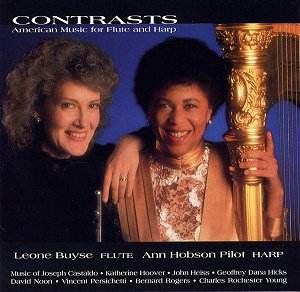|
|
Search MusicWeb Here |
|
 |
||
|
Founder:
Len Mullenger (1942-2025) Editor
in Chief:John Quinn
|
|
|
Search MusicWeb Here |
|
 |
||
|
Founder:
Len Mullenger (1942-2025) Editor
in Chief:John Quinn
|
 |
Contrasts. American music for
Flute and Harp David NOON (b 1946) Sonata da Camera for flute and harp op 89 Joseph CASTALDO (b 1927) Contrasts for solo harp Katherine HOOVER (b 1937) Kolopeli for solo flute Bernard ROGERS (1893-1968) Study for solo piccolo Charles Rochester YOUNG (b 1965) Song of the Lark for flute and harp John HEISS (b 1938) Four Lyric pieces for solo flute Vincent PERSICHETTI (1915-1987) Serenade No 10 for flute and harp Geoffrey Dana HICKS (b 1954) A Dream for alto flute and harp Ann Hobson Pilot, harp Recorded Seiji Ozawa Hall, Tanglewood, Boston July 18/19 1994 |
| CD available for post-free online mail-order or you may download individual tracks. For some labels you can download the entire CD with a single click and make HUGE savings. The price you see is the price you pay! The full booklet notes are available on-line. | |
|
NOTE • Click on the button and you can buy the disc or read the booklet details • You can also access each track which you may then sample or down load. • Further Information. |
|
|
The American flute and harp repertoire is very persuasively presented in this winning disc. Leone Buyse, a long time, now ex-, flautist in the Boston Symphony joins Ann Hobson Pilot, still that orchestra’s principal harpist, to record pieces of widely differing backgrounds – instrumentally, expressively, stylistically. The result is a satisfying blend and constitutes in itself an excellent recital. David Noon’s 1986 Sonata da Camera is an old-fashioned neo baroque concert opener – charming walking bass in the Overture, incisively vibrant repeated flute notes in the Vivo, effortless limpidity in the Sarabande and a bustling concluding Gigue. Castaldo’s Contrasts is a set of six etudes – all aphoristically brief – based on fellow composer and Castaldo’s teacher, Vincent Persichetti’s hymn, the tongue-twisting Purer than Purest Pure. It is cast in variation form and fully exploits the tonal and expressive potential of the harp – great arpeggios in the Allegro, taps on the sounding board in Misterioso and the awed return of the hymn theme in the concluding Allegro con spirito. Katherine Hoover’s Kokopeli (the mythical hero of a native tribe) employs a very wide range of dynamics the better to convey and conjure up vistas of the landscape of the Southwest of America, the land the ancient tribe inhabited. Exciting runs and tonal variety as well. Bernard Rogers was a contemporary of Piston, studied – most unusually for an American composer – with Frank Bridge and – far less unusually – with Nadia Boulanger in Paris. I like the register contrasts in his little three-minute piece and the subtle use of tonal gradations. The youngest composer represented is Charles Rochester Young, born in 1965, and a saxophonist. Inspired by Breton’s painting Song of the lark this is a three movement study both rippling and relaxed. In the second movement Young requires the harpist to use paper woven between her harp strings- it affords a veiled guitar effect, which is followed by some aggressive and percussive writing. In the final movement a musing flute is joined by the harp and together, affectionately, they reflect diminishing slowly into silence. Heiss’s Four Lyric Pieces is a very homogeneous work with a fine control of its lyricism. Heiss teaches flute and composition at the New England Conservatory and understands the effectiveness of contrastive sectional writing, cannily exploiting dynamics to emphasise the differences. I especially liked the witty ending of the Allegro scherzando –the equivalent of a semi-colon in music. The most well known of all the composers is Vincent Persichetti and his Serenade No 10 dating from 1957 is also the most well-known piece. It is a charmingly relaxed, superbly idiomatic work, folksy, elegant, affecting, with subtly varied material as well as fractiously inventive and exciting. Beginning with a Larghetto it ends on a mellow note, a suitable arc achieved. Geoffrey Dana Hicks ends the recital with his tender and inward little piece A Dream and a good way to end a beautifully played and eloquently recorded recital.
Jonathan Woolf |
| ADDITIONAL INFORMATION •
You can sample only 30 seconds (or 15% if that is longer) of a given track. Select from the View tracks list. Each sample will normally start from the beginning but you can drag the slider to any position before pressing play. • PLEASE NOTE: If you are behind a firewall and the sound is prematurely terminated you may need to register Ludwig as a trusted source with your firewall software.
•You will need Quicktime to hear sound samples. Get a free Quicktime download here • If you cannot see the "Sample All Tracks" button you need to download Flash from here.
|
|
|
Return to Index |